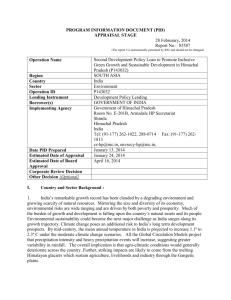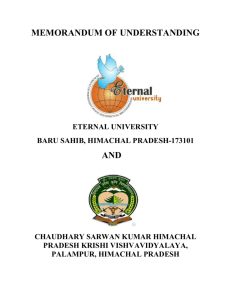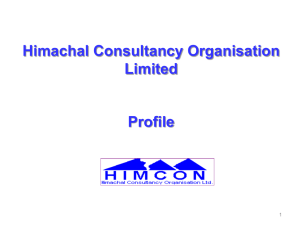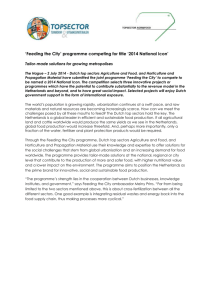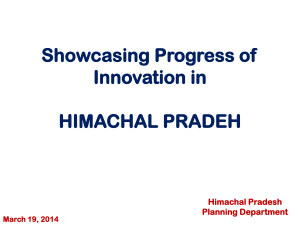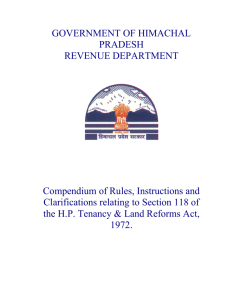project information document (pid) - Documents & Reports
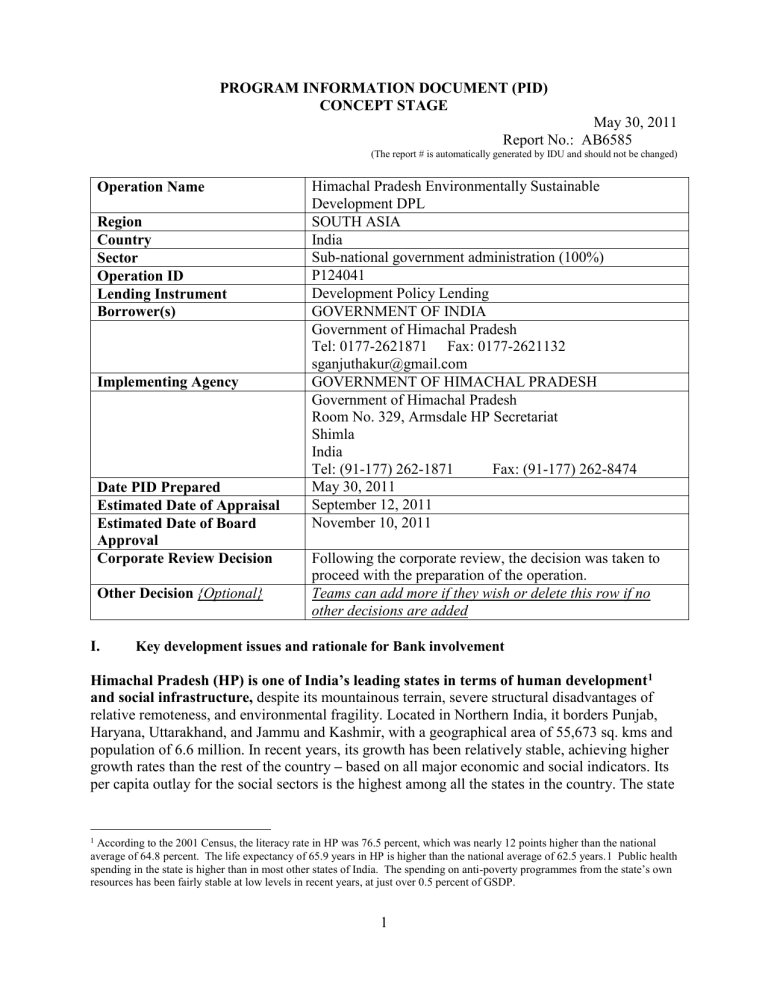
Operation Name
Region
Country
Sector
Operation ID
Lending Instrument
Borrower(s)
PROGRAM INFORMATION DOCUMENT (PID)
CONCEPT STAGE
May 30, 2011
Report No.: AB6585
(The report # is automatically generated by IDU and should not be changed)
Himachal Pradesh Environmentally Sustainable
Development DPL
SOUTH ASIA
India
Sub-national government administration (100%)
P124041
Development Policy Lending
Implementing Agency
GOVERNMENT OF INDIA
Government of Himachal Pradesh
Tel: 0177-2621871 Fax: 0177-2621132 sganjuthakur@gmail.com
GOVERNMENT OF HIMACHAL PRADESH
Government of Himachal Pradesh
Room No. 329, Armsdale HP Secretariat
Shimla
India
Tel: (91-177) 262-1871 Fax: (91-177) 262-8474
Date PID Prepared May 30, 2011
Estimated Date of Appraisal September 12, 2011
Estimated Date of Board
Approval
November 10, 2011
Corporate Review Decision
Other Decision {Optional}
Following the corporate review, the decision was taken to proceed with the preparation of the operation.
Teams can add more if they wish or delete this row if no other decisions are added
I.
Key development issues and rationale for Bank involvement
Himachal Pradesh (HP) is one of India’s leading states in terms of human development 1 and social infrastructure, despite its mountainous terrain, severe structural disadvantages of relative remoteness, and environmental fragility. Located in Northern India, it borders Punjab,
Haryana, Uttarakhand, and Jammu and Kashmir, with a geographical area of 55,673 sq. kms and population of 6.6 million. In recent years, its growth has been relatively stable, achieving higher growth rates than the rest of the country – based on all major economic and social indicators. Its per capita outlay for the social sectors is the highest among all the states in the country. The state
1 According to the 2001 Census, the literacy rate in HP was 76.5 percent, which was nearly 12 points higher than the national average of 64.8 percent. The life expectancy of 65.9 years in HP is higher than the national average of 62.5 years.1 Public health spending in the state is higher than in most other states of India. The spending on anti-poverty programmes from the state’s own resources has been fairly stable at low levels in recent years, at just over 0.5 percent of GSDP.
1
is an upstream macro watershed for the northwest region of India, with three major rivers, Beas,
Ravi and Chenab originating from here. The ecological criticality of the watersheds formed by these rivers transcends the territorial limits of the state. HP is a provider of significant public good (watersheds, conserved forests and associated ecological benefits) to the country.
Hydropower and tourism are key drivers of economic growth and development.
Hydropower is important in the state, not only as infrastructure and an engine of economic growth, but also as a key fiscal resource. Judicious exploitation of this resource would contribute significantly towards alleviating the power shortage in the country’s northern grid, and provide a source of “green energy, at the same time restore fiscal health in the state, a key element for sustainable development. There is considerable untapped potential in the sector, with about 32 percent of the potential developed. However, the most challenging dimensions of sustainable hydropower is the management of environmental and social impacts, with issues ranging from the management of water resources – sustaining and reducing variations in water flow, treatment of catchment areas for improved soil and water conservation, and assessing cumulative impacts arising from multiplicity of projects. Tourism is the other important sector where the state has tremendous potential due to its environmental, climatic, and natural heritage advantage. The sector also has the potential to creating productive work opportunities for educated workers, which is a major concern in HP. A challenge is the lack of an integrated vision, coordinated conservation of tourist attractions, based on carrying capacity and associated public infrastructure.
Agriculture and Horticulture remain important sectors of growth for the state This sector needs to remain viable and competitive as a large number of people depend on this; and therefore, requires more government support across the spectrum, from production (identification of crop, availability of quality seed/planting material, and packaging practices) to processing and marketing (through private agencies). The challenge is to sustain growth in these sectors through comprehensive strategy for land and water management and innovative organic certification programmes which at the same time will enable the sector to rise to market challenges.
HP has achieved progress in industrialization , more so since fiscal incentives were made available to industry. Actual realized industrial investment has increased by about 50 percent since 2003. The key sectors are cement, textiles, food processing, pharmaceuticals, engineering, electricals, and electronics. Since most industries and services develop in urban areas, productive and sustainable urban development would be a key to the state’s development agenda. Further, environment planning such as clustering of similar industries, would ease pressure on resources.
Addressing challenges in these key areas, would help promote private participation in the economy. It would also have additional desirable effects in terms of better living standards, improved connectivity for remote areas, and better employment opportunities for the educated population.
Government of Himachal Pradesh’s (GoHP) commitment towards environment conservation and sustainability is evident from various environmental initiatives at government and community level, most of which they have pioneered in the country. The broad objectives of the Government Program are to create a basis for sustainable development through sound environmental and natural resource management. Towards meeting these objectives the GoHP is focusing on: (i) identifying growth sectors which need immediate attention of policy makers - these include hydropower, tourism, agriculture and horticulture and industrial growth; (ii)
2
redefining strategy, policies and operational roles to address resource and environment challenges that have implications on the State’s economy; (iii) defining institutional and policy frame works, re-vitalizing capacity and skills and implementable action plans for effective results; (iv) ensuring maximum public participation in management of natural resources, and protection of the environment; (v) promoting climate resilient development and achieve carbon neutrality in Himachal Pradesh. To meet these broad objectives, the GoHP has requested the
Bank for an Environmentally Sustainable Development Policy Loan (HP ESD DPL) of US$200 million.
Rationale for Bank involvement
The Bank has a long standing and multi-disciplinary involvement in HP over the last 10 years supporting HP’s progress in the provision of infrastructure and services in key growth sectors, through the Nathpa- Jhakri, and Rampur and Hydro Power Projects, Integrated watershed Development Project, Mid Himalayan Watershed Project, State and Rural Roads projects and a DPL for fiscal reform. However, a number of challenging and residual issues related to sustainability of development still remain unaddressed, and cannot be ignored.
Barriers to development in HP still remain , the most significant of which include : relatively high per capita cost of development due to a fragile ecology, stressed land and water resources, and transport limitations; frequent natural disasters (landslides, cloudbursts, avalanches, floods) adversely affecting infrastructure and services
II.
Proposed Objective(s)
The HP DPL 1 (completed in May 2010) mostly delivered what it was supposed to do . The environmental policy actions were successful, and created demand for more improved environmental management. However, the current institutional capacity (which greatly improved in last 4 years) is still nascent to meet the challenges of economic (urban-industrial) growth, and the acute need to manage its natural resources in the best possible manner though HP is definitely much advanced in comparison to other hill States
The proposed HP ESD DPL will support the Government of India (GoI) and GoHP in its long term commitment to address environmental sustainability and climate change, its implications on development in ecologically fragile mountain ecosystems. GoHP has expressed interest to adopt and continue reforms in key areas, in knowledge and institutional building, and to encourage high ecological footprints sectors, to balance development and growth with environment protection and social responsibility. In this regard, the Bank has been requested by
GoHP and the Government of India (GoI) to provide support in the form of development policy lending.
The broad objective of the proposed Environmental sustainability DPL is to support GoHP to implement policy and institutional reforms to catalyze environmentally sustainable development . The following policy areas have been identified to support GoHPs development plan:
3
Policy area I: Environmentally Sustainable Hydro Development
Objective: To support policies and institutional reforms that would minimize the environmental and social impacts of hydro development.
Policy Area II: Environmentally Sustainable Tourism Development
Objective: To support policies and institutional reforms to minimize the adverse environmental impacts of tourism and promote eco-tourism.
Policy Area III: Environmentally Sustainable Industrial Development
Objective: To support policies and institutional reforms to strengthen environmental planning and pollution prevention and management in the industrial sector.
Policy Area IV: Environmentally Sustainable Agriculture and Horticulture
Objective: To support policies and institutional reforms that would enhance sustainability and growth in agriculture and horticulture through improved land and soil management and environmental practice.
Policy Area V: Sustainable Environment and Natural Resource Management through
Strengthened Environmental Institutions
Objective: To support policies and institutional reforms that would enhance environment and natural resource management for sustained growth in key sectors of the economy .
III.
Preliminary Description
The environmental sustainability oriented growth policies introduced under the current
Environmental Sustainability DPL are expected to bring out following impacts. It will allow the state to capitalize on its most abundant resources and comparative advantages of land, labor and water. Given HP’s unique geographic situation and small resource base, protecting rich natural resources assume greater importance than in other states.
Policy and institutional reforms implemented to minimize the potential environmental and social impacts of hydro development
Tourism and Eco-tourism operated in an environmentally sustainable manner
Green industrial development
Improved management of land and water for sustained growth in agriculture and horticulture
Environment criteria and attributes internalized in development decisions reported and monitored on regular basis.
4
IV.
Poverty and Social Impacts and Environment Aspects
Environment Aspects
The state of Himachal Pradesh is aware that key growth and revenue drivers in the medium term are critically dependent on the state’s natural resource base. While some environmental degradation inevitably accompanies growth, inaction or failure to balance the environmental costs of development with the benefits will have particularly serious consequences for the state—whose opportunities lie in sectors like horticulture/ agriculture, tourism, and hydropower which depend largely on environment and natural resources. The proposed HP ES DPL will help the state through corrective environmental sustainable policy shifts and will enable sustained growth by ,(i) synergizing GoI’s vision of mainstreaming environmental concerns into Gross
Domestic Product (green GDP) as an index of sustainable development (ii) improving water resources management by enabling integrated water resource planning and land management,
(iii) improving environmental practice in development sectors through sectoral guidelines; (iv) improving decision making through integrated data information systems,(v)strengthening and reengineering existing environmental institutions to develop capabilities to systematically assess how the state can maximize its natural advantage, and ensure application of environment norms across sectors, (vi) addressing emerging challenges by developing environment and climate change policies and action plans.; (vii) improve environment monitoring through citizens and community engagement mechanisms.
V.
Tentative financing
Source:
Borrower
International Bank for Reconstruction and Development
Borrower/Recipient
IBRD
Others (specify)
Total
($m.)
0
200
VI.
Contact point
World Bank
Contact: Sonia Chand Sandhu
Title: Senior Environmental Specialist
Tel: 5785+335
Fax:
Email: sonia@worldbank.org
Location: New Delhi, India (IBRD)
Borrower
Contact:
Title:
Tel:
Email:
5
VII.
For more information contact:
The InfoShop
The World Bank
1818 H Street, NW
Washington, D.C. 20433
Telephone: (202) 458-4500
Fax: (202) 522-1500
Web: http://www.worldbank.org/infoshop
6
